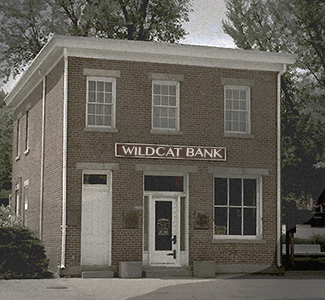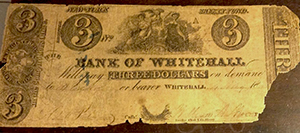By Matt Draiss
Basically the title says it all. My collection is old and obsolete. No, not that kind of old and obsolete, but it is a much more fun and fascinating kind of obsolete. I began collecting Obsolete Bank Notes a few years ago after I discovered them in a pamphlet on the subject from the American Museum of Finance in New York City on Wall Street. It was on my birthday when I was about 13 that the story begins. Ever since learning what a stock was I have been fascinated with finance. My father took me on my 13th birthday down to New York City and to Wall Street to see the stock exchange. During the trip, we discovered the museum. We went inside and saw all kinds of memorabilia from America’s financial history. I went into the gift shop and purchased a stock certificate from the New York Central Railroad to hang in my room, and on the way out the lady gave me a free pamphlet from the Society of Paper Money Collectors on Obsolete Bank Notes. I shoved the pamphlet to the side and was more fascinated with the fact that Warren Buffet had stood in the same building that I had. Several months later, I read that pamphlet and that is how I started collecting these fascinating Notes.
 The United States Government did not issue paper money on a regular time period until the Civil War. The only way for merchants and banks to conduct business was with coins or their own money. When times got tough, coins disappeared making things even more difficult. Obsolete Bank Notes and Merchant Scrip were issued from Colonial times through 1865. Some notes were issued after 1865, but that was a rare occurrence. Obsolete Bank Notes were issued in several different denominations ranging from $1 to even $2,000. Denominations issued in increment s of less than $1 are often referred to as “scrip.” Most of the time, notes issued by banks are called Obsolete Bank Notes and merchant issued notes are termed as “scrip.” The idea was basically the same: printing your own money to use for trade. The idea was that when you issued money from your bank you had enough coins to back it up. This did not always happen. A lot of banks would do the following example: Hold $5,000 in coins but issue $10,000 in paper money.
The United States Government did not issue paper money on a regular time period until the Civil War. The only way for merchants and banks to conduct business was with coins or their own money. When times got tough, coins disappeared making things even more difficult. Obsolete Bank Notes and Merchant Scrip were issued from Colonial times through 1865. Some notes were issued after 1865, but that was a rare occurrence. Obsolete Bank Notes were issued in several different denominations ranging from $1 to even $2,000. Denominations issued in increment s of less than $1 are often referred to as “scrip.” Most of the time, notes issued by banks are called Obsolete Bank Notes and merchant issued notes are termed as “scrip.” The idea was basically the same: printing your own money to use for trade. The idea was that when you issued money from your bank you had enough coins to back it up. This did not always happen. A lot of banks would do the following example: Hold $5,000 in coins but issue $10,000 in paper money.
Some states tightly regulated banks. Back then, it was easy to set up a bank and begin printing money. As time went on, the rules and regulations got tougher because banks were over extending themselves. This was not a good thing because the notes became worthless if the his happened, and this hence the term “broken bank note.” A lot of bank notes were counterfeit. During this time period, it was easy to print and make bad Bank Notes. Weekly reports called “registers” listed all of the known bad Bank Notes. Believe it or not, counterfeit and broken Bank Notes are highly collectible. During the 1860’s , the government passed a national banking act. This is what pretty much ended Obsoletes and started the National Bank Note era. The government started to crack down because many banks had failed and left the depositors “holding the bag.” The banks enjoyed issuing money with their names on it, so the new National Notes had each bank’s official name. If your bank did not switch from issuing private money to National Notes, you were taxed.
Obsolete Bank Notes can be collected in many combinations and ways. There are way too many to list here, but I will briefly tell you why I enjoy the method I chose. I live in New York, and New York banks and merchants issued many varieties and types of notes. New York is a big and well populated state, so that meant for a lot of issuers in many places. I live in the Capital Region and the Hudson Valley so a lot of history happened here relating to numismatics and paper money. I bought my first scrip note from a local dealer who had a few common notes in stock. This sparked an interest that has grown into an obsession. My goal is to collect every single note and variety type from every merchant and bank across the whole state. This is very similar to the article I wrote about in the July “Greysheet” regarding Civil War Tokens. Both of these tasks will take me a lifetime to complete. My collection now holds some notes that are quite rare. One of them may be the only one in existence.
 The primary sources for determining rarities and values for Bank Notes and scrip is through books and online auction records. Standard Catalog Of United States Obsolete Bank Notes (1782-1866} is the primary reference point. These books are out of date but provide a great starting point. These books cost several hundred dollars to purchase, but a cd version is available and it is much cheaper. The Society of Paper Money Collectors issued many books for Obsolete Bank Notes and Scrip for many different states. My primary reference points are the Heritage Auction archives and the Society’s New York book by Gordon Harris: New York State Scrip and Private Issues. A lot of these books are readily available at numismatic book auctions.
The primary sources for determining rarities and values for Bank Notes and scrip is through books and online auction records. Standard Catalog Of United States Obsolete Bank Notes (1782-1866} is the primary reference point. These books are out of date but provide a great starting point. These books cost several hundred dollars to purchase, but a cd version is available and it is much cheaper. The Society of Paper Money Collectors issued many books for Obsolete Bank Notes and Scrip for many different states. My primary reference points are the Heritage Auction archives and the Society’s New York book by Gordon Harris: New York State Scrip and Private Issues. A lot of these books are readily available at numismatic book auctions.
I hope you all enjoyed reading about a 17 year old’s old and obsolete collection. Obtaining a note from your area is a relatively easy accomplishment to achieve. A lot of states issued a lot of notes, so they are readily available. It is a great conversation starter to own a note from your local area. These notes offer a great escape from the troubles of everyday life and offer a time travel to the past. If these notes could talk, we wouldn’t need history class. Special thanks to Bill Panitch, Greg Rohan, and Carl Becker for proofreading and suggestions.
© 2013 Matt Draiss Numismatics & Galleries
***
CoinWeek YN is a continuing series of numismatic articles written by up-and-coming young numismatist writers and researchers. If you are under the age of 18 years old and would like to contribute, email your piece for consideration to [email protected].




